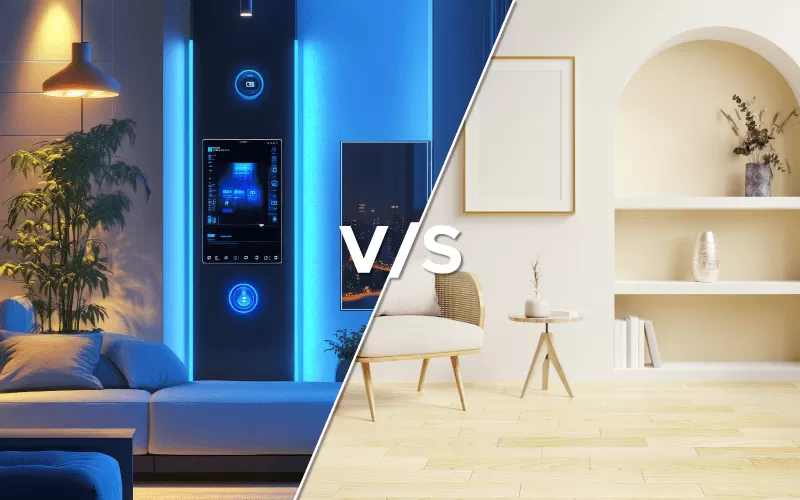
The world of real estate is evolving rapidly. While traditional apartments have long been the standard choice for urban dwellers, smart homes are reshaping the way we live. With automated features, energy-efficient systems, and enhanced security, smart homes promise convenience like never before. But are they really better than traditional apartments? Let’s explore the pros and cons of both to help you make an informed decision.
A smart home is equipped with advanced technology that allows residents to control various aspects of their living space through devices like smartphones, tablets, or voice commands. From lighting and temperature to security and entertainment systems, smart homes integrate multiple functions to simplify daily life.
Some popular features include:
Traditional apartments, on the other hand, are designed without integrated smart technologies. They focus on comfort, functional design, and sometimes luxury amenities, but without automated systems.
Features often found in traditional apartments include:
Despite lacking high-tech features, traditional apartments remain a reliable and cost-effective option for many residents.
Smart homes offer several advantages that appeal to tech-savvy residents and modern families.
Imagine turning on your lights, adjusting the thermostat, or even brewing coffee without lifting a finger. Automation simplifies everyday tasks, making life more comfortable and efficient.
Smart homes are often designed to reduce energy consumption. Smart thermostats, automated lighting, and energy-monitoring systems help lower utility bills and support sustainable living.
Advanced security features, such as smart locks, surveillance cameras, and motion detectors, provide peace of mind. You can monitor your home remotely, receive instant alerts, and even control who enters your home.
Smart homes are increasingly in demand. The integration of technology can increase property value and attract buyers or tenants looking for modern, tech-friendly living spaces.
Smart homes allow customization to suit individual lifestyles. You can create routines, automate appliances, and set preferences for lighting, temperature, and entertainment.

Despite their advantages, smart homes are not without drawbacks.
Installing smart devices and systems can be expensive. The upfront cost of a smart home may be significantly higher than a traditional apartment.
Smart home technology requires some level of technical knowledge. Setting up devices, troubleshooting, and maintaining systems can be challenging for those not tech-savvy.
Most smart home features rely on stable internet connections. A network outage can disrupt access to security systems, lighting, or other automated devices.
Connected devices collect data to function efficiently. This can raise privacy concerns, especially if systems are hacked or mismanaged.
Traditional apartments have stood the test of time for several reasons.
Without the cost of advanced technology, traditional apartments are generally more affordable, both in terms of purchase price and maintenance.
Living in a traditional apartment is straightforward. Residents can focus on comfort without worrying about complex automation or connectivity issues.
Fewer gadgets mean fewer things that can break down or require updates. Maintenance is simpler and more predictable.
Many residents prefer the comfort and familiarity of traditional apartments, which don’t require adapting to new systems or technology.
While traditional apartments are reliable, they have some limitations compared to smart homes.
Without technology, daily tasks such as managing energy consumption or home security require manual effort.
Investors or buyers looking for modern amenities might find traditional apartments less attractive. This could affect resale or rental value.
Traditional systems may not be optimized for energy savings, potentially leading to higher utility bills.
Residents have fewer options to personalize the living environment in terms of automation or integrated technology.

To better understand which option suits your needs, consider the following comparisons:
| Feature | Smart Homes | Traditional Apartments |
|---|---|---|
| Convenience | High (automation, remote control) | Moderate (manual systems) |
| Security | Advanced (smart locks, cameras) | Standard (locks, intercoms) |
| Energy Efficiency | High (smart thermostats, sensors) | Moderate to low (manual control) |
| Cost | High upfront cost | Affordable upfront cost |
| Maintenance | Moderate to high (tech upkeep) | Low (basic maintenance) |
| Resale/Rental Value | Potentially higher | Stable but may appeal to fewer buyers |
| Customization | High (personalized automation) | Low (limited options) |
Smart homes are ideal for:
Traditional apartments suit:
The line between smart homes and traditional apartments is gradually blurring. Many developers are integrating smart features into conventional apartments to offer a hybrid living experience.
Emerging trends include:
As technology becomes more accessible, smart homes may no longer be a luxury but a standard expectation in urban real estate.
Ultimately, the decision between a smart home and a traditional apartment comes down to lifestyle, budget, and priorities. If convenience, automation, and advanced security are crucial, smart homes are worth the investment. For those seeking simplicity, affordability, and low maintenance, traditional apartments remain a solid choice.
Balancing cost, functionality, and lifestyle preferences is key. Understanding the pros and cons of each option ensures you make a choice that enhances your living experience and aligns with your long-term goals.
Do Follow Estate Magazine on Instagram
Maximize Rental Yield in Dubai: Proven Tips for Smart Investors
